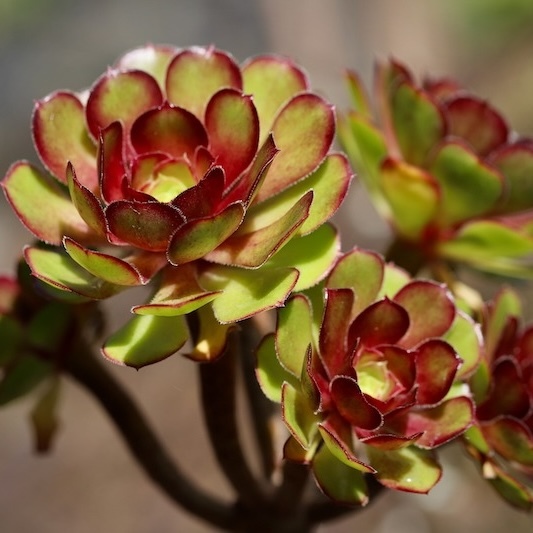Aeonium
About Aeonium

Tree Houseleek
Canary Islands, Madeira, North Africa.
Houseplants
Evergreen
9 - 11
Yellow, White, Pink, Red or Reddish-Orange
Late winter to early spring
Clumping, Columnar, Spreading, Upright, Mounded
Bees, Butterflies
Drought, Heat, Humidity, Wind
Deer, Rabbits, Moles, Diseases, Pests
Where To Grow Aeonium
Aeoniums are distinguished by their architectural rosettes of fleshy, spoon-shaped leaves, which can vary in color from deep green to burgundy. These succulents often develop bare stems that elevate the rosettes, giving them a tree-like appearance. Their forms range from ground-hugging plates to towering stems crowned with dark purple or variegated foliage. Grow them for architectural drama and low-maintenance adaptability.
Aeoniums are well-suited for rock gardens, where their structural form contrasts beautifully with stones and gravel. Place their geometric rosettes against soft grasses or cascading sedums in raised beds for visual impact. In mixed containers, pair dark cultivars with trailing blue chalksticks to emphasize chromatic depth, ensuring pots have gritty soil and drainage holes. Indoors, aeoniums make striking living sculptures beside silver-leaved companions.
Aeonium Care
Aeoniums thrive in well-draining soil with a slightly acidic pH around 6. A mix of one-third peat-based potting soil to two-thirds cactus mix provides optimal drainage. Position these succulents near east- or west-facing windows to receive bright, indirect light; insufficient light can lead to leggy growth. Water approximately once a week during active growth in winter and spring, and reduce watering to once or twice a month during summer dormancy. Fertilize sparingly, applying a balanced, slow-release granular fertilizer once in the spring.
Pruning aeoniums is generally unnecessary, but removing dead or damaged leaves can improve appearance and prevent pest issues. In colder climates, bring plants indoors when temperatures drop below 40°F (4°C) to protect them from frost. Aeoniums should be grown containers only slightly larger than the root ball, as these plants have shallow root systems. Repotting every 2-3 years during active growth in spring or fall helps maintain soil health and provides space for growth.
Learn More About Aeonium

Growing Aeonium Outdoors
Wait until nightly lows stay above 50 °F (10 °C), then harden the plant off for a week, shifting it from full shade to a spot that receives only morning sun or dappled light. Exposure that’s too intense will scorch the rosettes, so maintain bright but tempered light through summer, especially in regions with regular afternoon heat. Water sparingly—use a free-draining pot, keep it clear of sprinkler zones or downspouts, and shelter the container during prolonged rain. As autumn nights cool back to 50 °F, inspect for pests, quarantine if needed, and relocate the aeonium indoors before the first chill can damage its semi-dormant tissues.
Learn More About Growing Aeonium Outdoors






